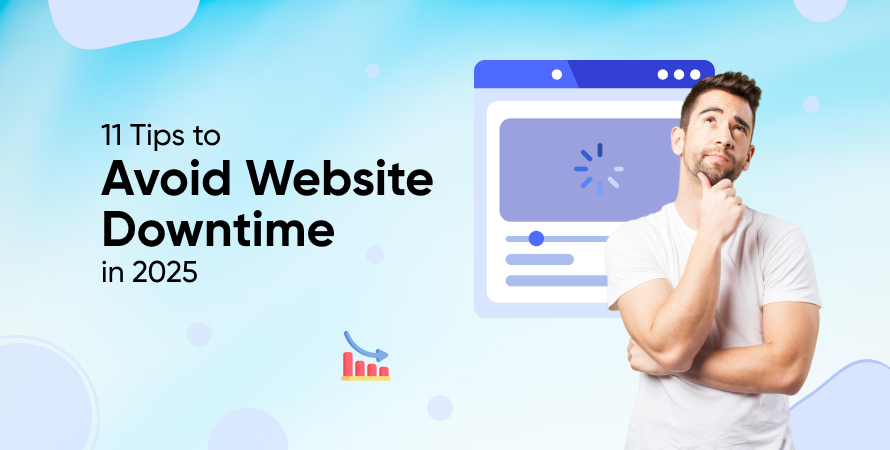11 Tips to Avoid Website Downtime in 2025



Introduction
In today’s digital-first economy, your website is often the primary touchpoint between your business and customers. Whether you’re a global brand or a small local business, maintaining your website’s availability 24/7 is crucial. Website downtime — when your site is inaccessible — can cost you more than just lost visitors. It can damage your brand reputation, hurt your SEO rankings, and significantly impact revenue.
As we move further into 2025, businesses face increased challenges with cyberattacks, traffic surges, and evolving technologies. Therefore, understanding how to prevent website downtime has never been more important. This comprehensive guide will walk you through 11 actionable tips to keep your website online and performing optimally all year round.
Website Downtime- Meaning and Causes
Website downtime refers to any period when a website is inaccessible or non-functional for users. This can range from a complete shutdown—where nothing loads—to partial outages, such as broken pages, forms that don’t submit, or server error messages.
Downtime can occur unexpectedly or be scheduled for maintenance. Regardless of the cause, even a few minutes of unplanned downtime can lead to lost traffic, revenue, and trust, especially if users encounter the issue during critical interactions such as purchases or form submissions.
Causes of Website Downtime
Before diving into prevention strategies, it’s essential to understand what causes site downtime. Knowing the root causes helps in addressing the right issues and tailoring your maintenance strategy effectively.
Web Server Failures
If your hosting server crashes or suffers hardware failure, your site will become unavailable. This can happen due to outdated hardware, poor maintenance, or resource overload.
DDoS Attacks and Cybersecurity Breaches
Distributed Denial of Service (DDoS) attacks flood your website with excessive traffic, overwhelming servers and making your site inaccessible. Similarly, malware infections and hacking can disrupt services.
Software Bugs and Coding Errors
Incorrect updates, conflicts between plugins, or buggy code can break your website functionality or cause crashes — often what is meant by breaking a website.
High Traffic Spikes
Unexpected surges in traffic, especially during marketing campaigns or product launches, can strain servers not designed to handle such loads, causing downtime.
Network Issues
Problems with internet service providers (ISP), DNS failures, or routing problems can prevent users from reaching your site, even if the server is up.
Maintenance and Updates Gone Wrong
Sometimes downtime happens during updates or migrations when things don’t go as planned.
Understanding these causes helps build a more robust prevention plan tailored to your website’s needs.
Why Uptime Is Critical for Digital Marketing Success
In the context of digital marketing, website uptime isn’t just a technical issue — it directly impacts your marketing results.
- SEO Impact: Search engines prioritize websites that are reliable and fast. If your site is frequently down, your search rankings will suffer, affecting organic traffic.
- Lost Leads and Revenue: Every minute your site is down means lost potential customers. For e-commerce and service-based businesses, downtime translates into tangible revenue loss.
- Brand Reputation: Users expect websites to be available and quick. Downtime damages trust, pushing customers to competitors.
- Marketing Campaign ROI: Whether paid ads, email campaigns, or social media promotions, sending users to a non-functional site wastes budget and opportunity.
A digital marketing agency understands these impacts deeply and often integrates uptime monitoring and website performance strategies into their campaigns to maximize results.
11 Actionable Tips to Avoid Website Downtime in 2025
1. Choose a Reliable Hosting Provider
The foundation of uptime begins with your hosting plan. Not all hosting providers are created equal.
- Look for hosts with uptime guarantees of 99.9% or higher.
- Consider cloud hosting, which offers better redundancy and scalability compared to traditional shared hosting.
- Research reviews and uptime histories before committing.
- Don’t compromise on support—responsive customer service is critical during outages.
2. Implement Website Monitoring Tools
You can’t fix what you don’t see. Monitoring tools keep a constant check on your website’s downtime status.
- Use services like Pingdom, UptimeRobot, or New Relic.
- These tools notify you immediately if your site is down for everyone.
- Regular monitoring helps detect intermittent problems before they become major outages.
3. Set Up Automated Backups
Backups are your safety net.
- Schedule automatic daily backups of your site files and databases.
- Store backups offsite or in cloud storage.
- In case of an emergency—whether a hack, broken update, or server failure—restoring a backup minimizes downtime.
4. Optimize Your Website’s Code & Plugins
Poorly written code or incompatible plugins are common causes of website crashes.
- What is meant by breaking a website often relates to code conflicts or errors introduced during updates.
- Regularly audit your website code.
- Remove unused or outdated plugins.
- Test updates on a staging environment before going live.
5. Use a Content Delivery Network (CDN)
A CDN distributes your website’s content across multiple global servers.
- This reduces load times for users everywhere.
- CDNs add redundancy — if one server fails, traffic is rerouted to another.
- CDNs also absorb some DDoS traffic, protecting your site.
6. Regularly Test Website Load Performance
Load testing helps ensure your infrastructure can handle traffic surges without crashing.
- Conduct load tests especially before big product launches or marketing campaigns.
- Use tools like Apache JMeter or Loader.io.
- Identify bottlenecks and optimize server or code performance accordingly.
7. Keep Software, Themes, and Plugins Updated
Updates aren’t just about features; they fix security vulnerabilities and bugs that can cause downtime.
- Make it a routine to update all site software.
- Always back up before applying updates.
- Many downtime incidents stem from ignoring updates or rushing them without testing.
8. Implement Robust Security Measures
Cyberattacks are a major source of downtime.
- Use firewalls, web application firewalls (WAF), and DDoS mitigation services.
- Enable HTTPS with SSL certificates.
- Regularly scan for malware and suspicious activity.
9. Set Up a Scalable Infrastructure
Your hosting should grow with your business.
- Auto-scaling cloud environments dynamically add resources during traffic spikes.
- Prevent downtime caused by traffic overload.
- Scalability is essential for seasonal businesses and growing startups.
10. Have a Clear Incident Response Plan
Downtime is sometimes inevitable. What matters is how quickly you respond.
- Define roles and responsibilities for your team.
- Keep contact lists for support, hosting providers, and developers ready.
- Use communication tools to notify stakeholders promptly.
- A fast, organized response reduces downtime and customer frustration.
11. Consult Web Performance Experts
Sometimes the best investment is expert advice.
- Performance consultants specialize in Core Web Vitals — Google’s set of metrics impacting search ranking and user experience.
- Experts can audit your infrastructure and site, identifying hidden risks.
A digital marketing agency or Core Web Vitals consultants can integrate uptime optimization into your broader growth strategy.
How to Know If Your Site is Down for Everyone
Sometimes, what seems like downtime is a local issue.
- Tools like DownDetector, IsItDownRightNow, or Site24x7 show global status.
- Check multiple devices and networks.
- If your site is down for everyone, contact your host or IT immediately.
- Understanding this distinction saves wasted troubleshooting time.
What is the Cost of Website Downtime?
Website being down for maintenance is costly, but the exact cost varies.
- Studies estimate businesses lose thousands per minute when offline, depending on industry.
- E-commerce sites face direct revenue loss with every missed transaction.
- SEO rankings drop if downtime persists, impacting long-term organic traffic.
- Paid campaigns sending users to a down site waste budget.
- Brand damage from lost trust is difficult to quantify but very real.
Knowing the cost helps justify investments in website downtime prevention and monitoring.
Conclusion
Downtime for websites in 2025 can be a serious problem, but the good news is that it can be prevented. By taking the right steps—like choosing a reliable hosting provider and keeping your site secure and well-maintained—you can greatly lower the risk of your website going offline.
The 11 tips shared in this guide give you a solid plan to keep your website running smoothly, quickly, and safely. This is important not just for your users, but also for the success of your digital marketing efforts.
If you want expert help to make your website even faster and more reliable, think about working with Core Web Vitals consultants. They focus on improving site performance and uptime, so your business can stay strong in today’s competitive online world.
Frequently Asked Questions (FAQs)
Website downtime can be caused by server failures, cyberattacks, coding errors, traffic overload, network issues, or maintenance mishaps.
Use online tools like DownDetector or IsItDownRightNow to see if your website is inaccessible globally or just from your location.
Breaking a website typically refers to introducing errors or conflicts in the website’s code or plugins that cause the site to malfunction or crash.
Costs vary widely but can include thousands of dollars lost per minute in revenue, SEO ranking drops, wasted advertising budget, and brand damage.
Yes. Many agencies offer website performance optimization and monitoring services to ensure campaigns run smoothly without site outages.